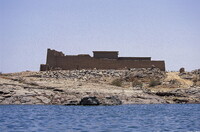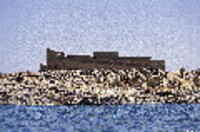| dc.coverage.spatial | Site: New Kalabsha Reconstruction (Aswan, Upper Egypt, Egypt) | en_US |
| dc.coverage.temporal | relocated ca. 1970 (restoration) | en_US |
| dc.creator | unknown (Egyptian (ancient)) | en_US |
| dc.date.accessioned | 2013-04-17T18:20:32Z | |
| dc.date.available | 2013-04-17T18:20:32Z | |
| dc.date.issued | 2013-04-17 | |
| dc.identifier | 208976 | en_US |
| dc.identifier.other | archrefid: 981 | en_US |
| dc.identifier.uri | http://hdl.handle.net/1721.3/116856 | |
| dc.description | General view, looking south, showing present location on an island in Lake Nasser; When Egypt became an unofficial British protectorate in the late 19th century, it was decided to construct a dam at Aswan to control the inundation and to create a reserve of water for irrigation. However, the Aswan Dam, completed in 1902, proved inadequate and was replaced by the Aswan High Dam, built with Russian assistance in the 1960s. The consequent creation of Lake Nasser threatened the destruction of numerous ancient monuments, the most important of which were saved by a relocation programme carried out under UNESCO auspices. Relocated temples in the vicinity of Aswan include the Philae temples on Agilqiyya Island and the temples of Kalabsha and Beit el-Wali at New Kalabsha on the lake shore. Source: Grove Art Online; http://www.groveart.com/ (accessed 1/18/2008) | en_US |
| dc.format.medium | stone; limestone | en_US |
| dc.rights | © Scott Gilchrist, Archivision, Inc. | en_US |
| dc.subject | architectural exteriors | en_US |
| dc.subject | Egypt--Civilization | en_US |
| dc.title | Kalabsha [reconstructed site] | en_US |
| dc.type | image | en_US |
| dc.rights.access | Licensed for educational and research use by the MIT community only | en_US |
| dc.identifier.vendorcode | 1A3-EG-K-1-A2 | en_US |
| vra.culturalContext | Egyptian (ancient) | en_US |
| vra.technique | construction (assembling) | en_US |
| vra.worktype | excavation (site) | en_US |
| dc.contributor.display | unknown (Egyptian (ancient)) | en_US |



